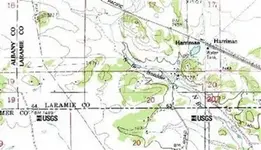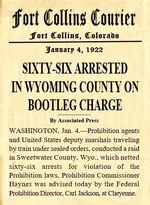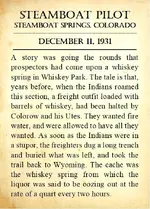In 1919, when Prohibition outlawed alcoholic beverages, some towns in Wyoming were centers for the sale of sinful pleasures in the region. With Prohibition, law enforcement officers had been given an impossible task: to stamp out the liquor business among people who still very much liked to drink. And, gambling, though illegal, was practiced openly in eateries and saloons, too. After the 1919 Prohibition laws went into effect, liquor, wine, and beer, were often openly available in eating and drinking establishments.
Although Casper was about 150 miles from Laramie, it too became a mecca for bootleggers. At that time, Casper’s population was around 17,000 people, but countless numbers of the citizenry were prostitutes. Wyoming’s oil drilling, refining, mining, ranching and railroad economy attracted a lot of single men with money to spend at Casper’s brothels and speakeasies clustered in the Sandbar district, just northwest of downtown.
Town and county officials, as well as the police and sheriff’s officers had to have known about the city’s illegal activities. But, either they were paid to ignore these crimes of pleasure or believed that arrest and prosecution would be futile since it would be hard to prove in a court of law.
From the beginning, and as Prohibition continued, contempt for the officers and for the law itself continued to spread. Bootleggers made more and more money, and were happy to pay police to leave them alone. Corruption spread through law enforcement from top to bottom. So, in 1919, the Wyoming Legislature set up a new agency specifically to enforce Prohibition statewide. Federal officers were needed whose authority reached statewide.
Governor Robert Carey appointed Fred Crabbe, president of the Wyoming chapter of the Anti-Saloon League, to head the new state Prohibition agency. Crabbe’s first hire was John Cordillo, a former policeman with Prohibition enforcement experience in Colorado. He brought his brother Pete with him, as well as another Colorado policeman named Walter Newell. It did not take them long to make headlines.
According to the Laramie Daily Boomerang in its article entitled, "$22,000 in Booze Seized in Laramie," published in the September 3, 1919 edition, the agents “immediately began an undercover investigation of bootlegging activity along Front Street. A few days later, on August 26, Crabbe and his deputy Daniels, accompanied by the Cordillos and Newell set up a raid in cooperation with local lawmen. The Tuesday night operation was a spectacular success in which six establishments were raided, five men and one woman arrested and 400 gallons of illegal booze, worth an estimated $22,000, was seized.”
Then, two days later, another Boomerang article showed how much director Crabbe appreciated the attention. The September 5, 1919, headline read: “Boomerang Thanked by Crabbe for Its Excellent Write-up on Bootleg Raid.”
But, three days after that celebration turned to sorrow, when the Laramie Daily Boomerang reported the tragic murder of a popular local ranchman. The front page headline of its September 8, 1919, edition read: "Ranchman, with Bullet Hole in Head, Found Dead." This tragic event pushed the spectacular successes of Crabbe’s “bootleg squad” out of the front pages.







